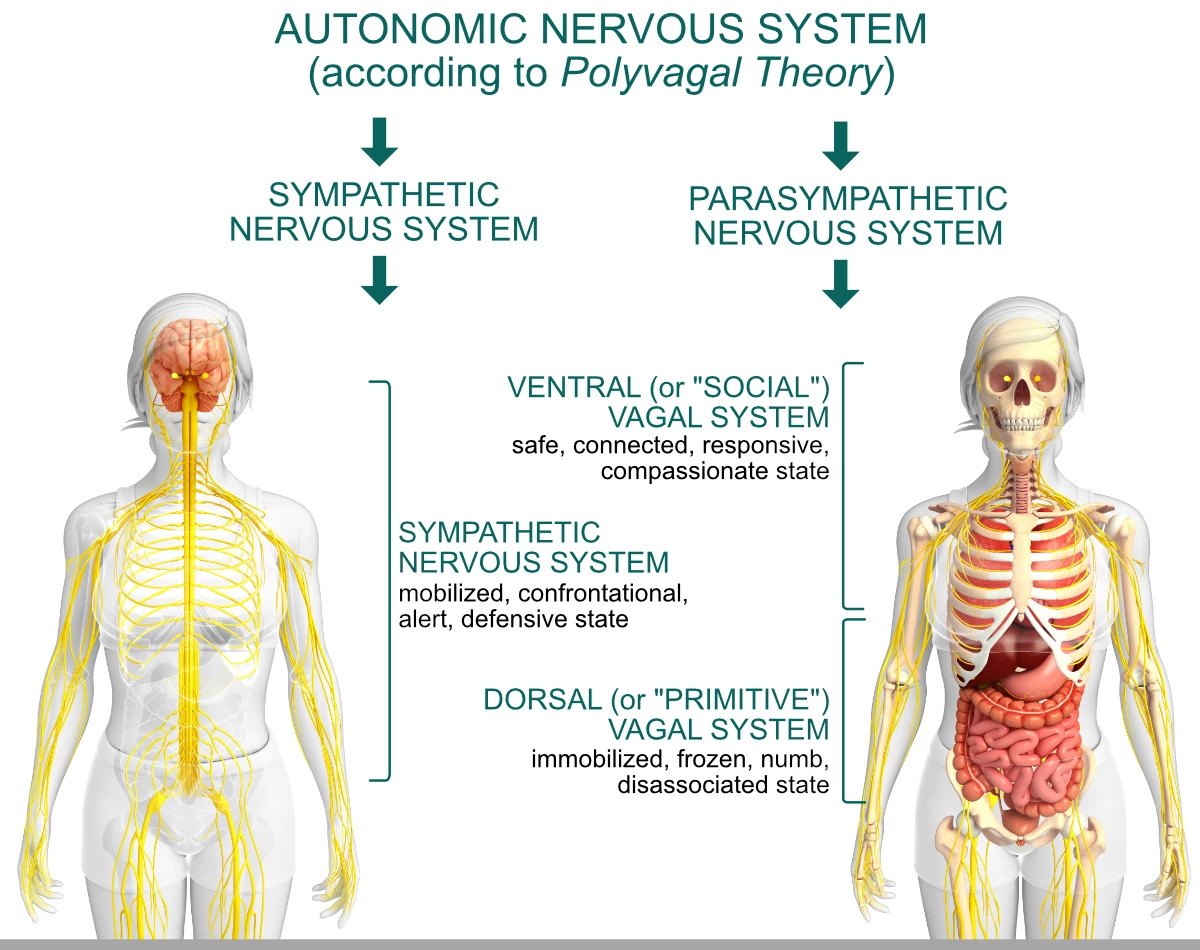The Autonomic Nervous System and Yoga’s Three Gunas

When my son was a baby, he used to wake up several times per night. After putting him back to sleep, I would lie in my bed, awake for hours listening for sounds coming from his room. Eventually, I realized that this kind of alert listening prevented me from falling asleep. When I purposefully stopped listening, I was able to fall asleep much faster.
It turns out, there is a reason for that. When you are in a sympathetic state (fight-or-flight mode), “the middle ear regulation shifts away from listening for human voice toward listening for low-frequency sounds of predators or high-frequency sounds of distress.”(1) Since I was intently listening for high-frequency sounds of a baby crying, I was inadvertently putting myself into a sympathetic state, which made it very hard to fall asleep.
Although those days of newborn parenting now seem like a blur, I still remember myself fluctuating between the states of total numbness from exhaustion, frenetic mobilization to get anything done, and peaceful, happy feelings of pure love. Turns out, we reliably travel between those states regularly, both within the space of one day, and throughout our lives, and we have our autonomic nervous system to thank for that.
What is the Autonomic Nervous System?
Your autonomic nervous system (ANS) is concerned with your survival during times of danger and thriving during the times of safety. It is constantly evaluating your external and internal environment for signs of danger and jumps to your defense before those signs even rise to the level of your conscious awareness. Even though we usually think of two branches of the autonomic nervous system as the main driving forces that regulate your homeostasis and inner balance, there is a theory that suggests that there are actually three neurological pathways built into us that drive our physiological reactions.
The autonomic nervous system is made up of two branches: the sympathetic and the parasympathetic. The sympathetic branch is a bundle of nerves that are found in the middle of the spinal cord. These nerves connect to every major organ and initiate the fight-and-flight response throughout your entire system (dilating pupils, speeding up the heart rate and breathing, secreting adrenaline, and so on).
We usually think of our sympathetic system as a gas pedal that gets you going. The parasympathetic branch is usually associated with rest-and-digest response and is essentially made up of the fascinating vagus nerve. It is usually described as a counterbalance to the fight-or-flight response that brings you back to the state of equilibrium. We typically think of it as a foot brake that you press when you need to slow down and regroup.

The Polyvagal Theory
However, the Polyvagal Theory pioneered by Dr. Porges takes it one step further (2). It looks at the entire autonomic nervous system through the lens of our essential needs for safety and connection to other human beings. The Polyvagal Theory stipulates that there are actually two kinds of “brakes” we have built into our systems—a regular “foot brake,” and an “emergency brake.” Both of those brakes get activated by the vagus nerve under different conditions.
The vagus nerve is divided into two distinct pathways that serve two very different functions. Those two branches of the nerve travel together from the brainstem and split at the level of the diaphragm. The dorsal vagus travels downward and affects the organs underneath the diaphragm, especially those regulating digestion, and the ventral vagus travels upward and influences the heart rate and breathing rate, as well as regulates connections with facial nerves. Deb A. Dana, in her book “The Polyvagal Theory in Therapy,” writes that because of these unique pathways, “each autonomic state brings a characteristic range of responses through its own pattern of protection and connection.”(1)

The Vagus Nerve and Yoga’s 3 Gunas
Dorsal (or “primitive”) vagus activation (emergency brake) stops you dead in your tracks and makes you feel frozen, numb, or “not here.” Your system is drained, and your energetic resources are being conserved through collapse and total shutdown. This happens when there is a major trauma or life threat (and in the aftermath of those), and when you feel completely exhausted or lost. This can be a consequence of illness, injury, or medical procedure on any organ below the diaphragm. It can manifest through impaired immune function, a chronic lack of energy, digestive issues, depression, and general withdrawal from social connection. This is a hypo-aroused state. In yoga, we would call it a tamasic state.
The sympathetic system (gas pedal) gets activated when you need to take action. You are still searching for protection and safety, but in this state, you do it through the mobilization of your resources. Your entire body is on high alert and ready for action, which also means that you see, hear, and sense danger everywhere. When you are in the sympathetic state, you are more likely to initiate confrontation, to misread facial clues, and less likely to connect to other people. This state can manifest as frenetic movement, busyness, fidgeting, and overall defensiveness. This is a hyper-aroused state. In yoga, we would call it a rajasic state.
Ventral (or “social”) vagus activation (foot brake) encourages you to slow down and puts you in the state of safety and connection. Deb A. Dana writes: “In the ventral vagal state, we have access to a range of responses including calm, happy, meditative, engaged, attentive, active, interested, excited, passionate, alert, ready, relaxed, savoring, and joyful.”(1) In this state, you are most open to connecting with others, the world seems like a welcoming place full of possibility, and you can feel compassion toward both yourself and others. “In the ventral vagal state, hope arises, and change happens.”(1) In this state, you feel safe and open to social connections. In yoga, we would call it a sattvic state.
This theory closely reflects the yogic idea of the three gunas (tamas, rajas, and sattvas), and demonstrates how gunas are reflected in your autonomic nervous system. Your autonomic nervous system is a foundation upon which your entire lived experience is built. Most of us move through those three states throughout the day in response to the sensations within the body and signals from the environment. Do we move through those states in a particular order? What impacts that transition? Do we have any conscious control over it? And what does it have to do with teaching yoga?
Also, read...
No Muscle Is an Island – Are You Making This Common Strength Training Mistake?
Discovering the Living Body: A Yoga Teacher’s Revolutionary Insight on Fascia
The Fascia Connection: Tom Myers on How Postural Habits Get Locked into Our Fascial System
Related courses

Educated as a school teacher, Olga Kabel has been teaching yoga for over 14 years. She completed multiple Yoga Teacher Training Programs but discovered the strongest connection to the Krishnamacharya/ T.K.V. Desikachar lineage. She had studied with Gary Kraftsow and American Viniyoga Institute (2004-2006) and received her Viniyoga Teacher diploma in July 2006, becoming an AVI-certified Yoga Therapist in April 2011. Olga is a founder and managing director of Sequence Wiz— a web-based yoga sequence builder that assists yoga teachers and yoga therapists in creating and organizing yoga practices. It also features simple, informational articles on how to sequence yoga practices for maximum effectiveness. Olga strongly believes in the healing power of this ancient discipline on every level: physical, psychological, and spiritual. She strives to make yoga practices accessible to students of any age, physical ability, and medical history, specializing in helping her students relieve muscle aches and pains, manage stress and anxiety, and develop mental focus.
- The Polyvagal Theory in Therapy: Engaging the Rhythm of Regulation by Deb A. Dana
- https://www.stephenporges.com/



